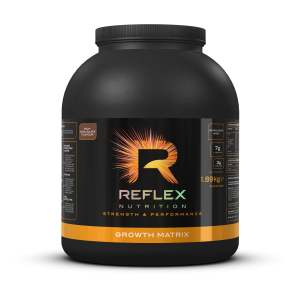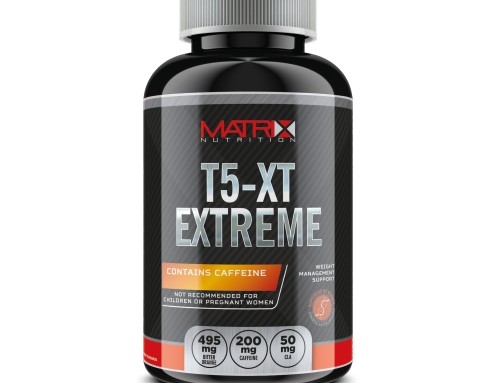Reflex Nutrition Growth Matrix
Growth Matrix is a supplement produced by UK based brand, Reflex Nutrition. This supplement is said to help with Muscle Growth and recovery post exercise. This review will assess the ingredients listed within this supplement to identify whether these claims can be backed up.
Ingredients
Glucose Polymers (Maltodextrin)
Maltodextrin is a polysaccharide which is a complex carbohydrate. This ingredient is water soluble and unlike other carbohydrates, is easily digestible (1) and can give a quick release of energy without any spikes of glycaemia (2).
High DH Hydrolysed Whey Protein (~30 %) (30 % degree of hydrolysis) (MILK)
Whey Protein is the most popular and widely used protein powder. It is derived from milk and is the watery part that separates when making cheese.
Unlike some plant based proteins whey protein has all amino acids so there is no need to find them from different sources. Whey protein is quickly absorbed and used in large amounts by your body immediately If you are lactose intolerant it is recommended not to go for whey protein due to bloating, flatulence, stomach ache or even fatigue.
No matter what type of protein, all varieties help aid muscle protein synthesis when combined with resistance training (3,4). Other key features include increasing muscle mass (5), an increase in lean body mass (6) and greater recovery from exercise (7). Longer periods of supplementation have shown greater gains in fat free mass (8).
Although these benefits are seen, the efficiency and degree of change can differ significantly depending on the availability of the amino acids. Below lists some of the major types of protein powders available. The recommended amount to consume is around 20 – 30 grams, which can be spread throughout the day (e.g 4-6 x 5g).
L-Leucine
Leucine is one of several Branched chain amino acids (BCAA’s). It is essential for protein synthesis which is stimulated after exhaustive exercise (9) as well as the critical metabolic process in muscle (10, 11). The metabolic roles of Leucine include energy production and the modulator of muscle protein synthesis via the insulin signalling pathway. There is a reason to suggest that it helps maintenance of muscle mass during weight loss (12). Leucine has also been shown to help in the direct maintenance of glucose homeostasis by improving the redistribution of glucose via the glucose – alanine cycle (13).
Peptide- Bonded Glutamine (WHEAT),
Wheat gluten is the main protein of wheat. A desired property of gluten is its ability to bind fat and water while at the same time increasing the protein content (14).
Cocoa Powder (rich chocolate variety only)
Cocoa powder has been found to include flavonoids which are antioxidants, they can aid in the oxidation of LDL, (15,16) and augments the antioxidant defence system (17). Cocoa powder has also been found to stimulate nitric oxide production which can reduce oxidative stress and reduce the risk of heart attack (18).
Creatine Monohydrate (Creapure®)
Creatine monohydrate, (CM) is defined as a nitrogenous organic acid that occurs naturally in humans and aids in the supply of energy to cells in the body, (19). The majority of CM, 95%, can be located in the skeletal muscle with the rest distributed to the brain, heart and smooth muscles.
Creatine has been found to increase the replenishment of ATP stores in the skeletal muscles (20). It is attributed to a greater rate of phosphocreatine resynthesis during the rest periods. Higher sprint speeds reported (21). There have been numerous theories proposed as to why creatine is a benefit to short term high intensity exercise (22). One theory is that the increased amount of phosphocreatine, (PCr), can be used as an immediate buffer to ATP which reduces the dependence of glycolysis which delays the production of lactate and hydrogen ions during exercise thus prolonging the activity by delaying the onset of fatigue, (23).
Thickener (Carboxymethyl Cellulose)
Carboxymethyl cellulose is water-soluble and derived from cellulose. Carboxymethyl cellulose is used as a viscosity modifier or thickener, and to stabilize emulsions in various supplements and other products. It is known for its excellent water retaining capacity.
Colouring (Beta Carotene [smooth fruit variety only])
Beta Carotene is a red / orange pigment that is derived from root vegetables such as carrots.
Sweetener (Acesulfame K)
Acesulfame K is a sweetener that is calorie free. This ingredient is used in many products and is used to make the product taste sweeter and does not have any nutritional benefit.
Sodium Chloride
Sodium chloride is otherwise known as salt. It is theorised that sodium chloride can help prevent cramps as the key mechanism in muscle contraction is the flooding of the action potential in the muscle membrane, and so if there is a sodium deficiency it may cause the muscle to cramp (24).
Sweetener (Sucralose)
Sucralose is a sweetener that is calorie free. This ingredient is used in many products and is used to make the product taste sweeter and does not have any nutritional benefit.
Pyridoxine Hydrochloride.
Pyridoxine hydrochloride is a form of Vitamin B6. The active form of vitamin B6 is known as P-L-P (25), which is stimulated by exercise (26). During exercise the body relies on the liver to produce glucose via glycogenolysis, for which vitamin b6 is essential for, and is an integral part of the glycogen phosphorylase enzyme and thus will provide energy to the bodies’ muscles (27).
Summary
Growth Matrix can be used by people who want to gain muscle. This supplement is best taken post-workout. This product has no banned substances in reference to the WADA prohibited list when observing the label / ingredients posted on the website..
*NOTE – This product has not been tested in a laboratory and may contain other substances that may not appear on the label
References
1 – Haralampu, S. G. (2000). Resistant starch—a review of the physical properties and biological impact of RS< sub> 3</sub>. Carbohydrate polymers, 41(3), 285-292.
2 – Roberts, M., Lockwood, C., Dalbo, V. J., Tucker, P., Frye, A., Polk, R., … & Kerksick, C. (2009). Ingestion of a high molecular weight modified waxy maize starch alters metabolic responses to prolonged exercise in trained cyclists. In FASEB abstract.
3 – Coker, R. H., Miller, S., Schutzler, S., Deutz, N., & Wolfe, R. R. (2012). Whey protein and essential amino acids promote the reduction of adipose tissue and increased muscle protein synthesis during caloric restriction-induced weight loss in elderly, obese individuals. Nutr J, 11(1), 105.
4 – Hulmi, J. J., Lockwood, C. M., & Stout, J. R. (2010). Review Effect of protein/essential amino acids and resistance training on skeletal muscle hypertrophy: A case for whey protein.
5 – Pasiakos, S. M., McLellan, T. M., & Lieberman, H. R. (2015). The effects of protein supplements on muscle mass, strength, and aerobic and anaerobic power in healthy adults: a systematic review. Sports Medicine, 45(1), 111-131.
6 – Volek, J. S., Volk, B. M., Gómez, A. L., Kunces, L. J., Kupchak, B. R., Freidenreich, D. J., … & Kraemer, W. J. (2013). Whey protein supplementation during resistance training augments lean body mass. Journal of the American College of Nutrition, 32(2), 122-135.
7 – Hansen, M., Bangsbo, J., Jensen, J., Bibby, B. M., & Madsen, K. (2014). Effect of Whey Protein Hydrolysate on Performance and Recovery of Top-Class Orienteering Runners. International journal of sport nutrition and exercise metabolism.
8 – Hartman, J. W., Tang, J. E., Wilkinson, S. B., Tarnopolsky, M. A., Lawrence, R. L., Fullerton, A. V., & Phillips, S. M. (2007). Consumption of fat-free fluid milk after resistance exercise promotes greater lean mass accretion than does consumption of soy or carbohydrate in young, novice, male weightlifters. The American journal of clinical nutrition, 86(2), 373-381.
9 – Tipton, K. D., Ferrando, A. A., Phillips, S. M., Doyle Jr, D., & Wolfe, R. R. (1999). Postexercise net protein synthesis in human muscle from orally administered amino acids. American Journal of Physiology-Endocrinology And Metabolism, 276(4), E628-E634.
10 – Hutson, S. M., & Harris, R. A. (2001). Introduction. Symposium: Leucine as a nutritional signal. The Journal of nutrition, 131(3), 839S-840S.
11 – Layman, D. K. (2002). Role of leucine in protein metabolism during exercise and recovery. Canadian journal of applied physiology, 27(6), 646-662.
12 – Layman, D. K. (2003). The role of leucine in weight loss diets and glucose homeostasis. The Journal of nutrition, 133(1), 261S-267S.
13 – Herman, M. A., & Kahn, B. B. (2006). Glucose transport and sensing in the maintenance of glucose homeostasis and metabolic harmony. The Journal of clinical investigation, 116(7), 1767-1775.
14 – Day, L., Augustin, M. A., Batey, I. L., & Wrigley, C. W. (2006). Wheat-gluten uses and industry needs. Trends in Food Science & Technology, 17(2), 82-90.
15 – Bearden MM, Pearson DA, Rein D, et al. Potential cardiovascular health benefits of procyanidins present in chocolate and cocoa. In: Parliment TH, Ho C-T, Schieberle P, eds. Caffeinated beverages: health benefits, physiological effects, and chemistry. Washington, DC: American Chemical Society, 2000:177–186
16 – Pearson DA, Schmitz HH, Lazarus SA, Keen CL. Inhibition of in vitro low-density lipoprotein oxidation by oligomeric procyanidins present in chocolate and cocoas. In: Packer L, ed. Methods in enzymology. Vol. 335. New York: Academic Press, 2001:350–60.
17 – Keen, C. L., Holt, R. R., Oteiza, P. I., Fraga, C. G., & Schmitz, H. H. (2005). Cocoa antioxidants and cardiovascular health. The American journal of clinical nutrition, 81(1), 298S-303S.
18 – Osakabe N, Sanbongi C, Yamagishi M, Takizawa T, Osawa T. Effects of polyphenol substances derived from Theobroma cacao on gastric mucosal lesion induced by ethanol. Biosci Biotechnol Biochem 1998;62:1535–8.
19 – Balsom, P. D., Soderlund, K., & Ekblom, B. (1994). Creatine in humans with special reference to creatine supplementation. Sports Medicine. 18(4), 260 – 280.
20 – Greenhaff, P.L., Bodin, K., Soderlund, K., Hultrnan, E. (1994). The influence of oral creatine supplementation on muscle phosphocreatine resynthesis following intense contraction in man. American Journal of Physiology, 266(5), 725-730.
21 – Jones, A. M., Atter, T., & Georg, K. P. (1999). Oral creatine supplementation improves multiple sprint performance in elite ice-hockey players. Journal of sports medicine and physical fitness, 39, 189-196.
22 – Hultman, E., Soderland, K., Timmons, J. A., Cederblad, G. & Greenhaff, P. L. (1996). Muscle creatine loading in men. Journal of Apllied Physiology. 81(1), 232-237.
23 – Casey, A., Constantin – Teodosiu, D., Howell, S., Hultman, E., & Greenhaff, P. L,. (1996). Creatine ingestion favourably affects performance and muscle metabolism during maximal exercise in humans. American Journal of Physiology. 271(1), 31-37.
24 – McCance, R. A. (1936). Experimental sodium chloride deficiency in man.Proceedings of the Royal Society of London. Series B, Biological Sciences,119(814), 245-268.
25 – Ubbink, J. B., Vermaak, W. J., van der Merwe, A., & Becker, P. J. (1993). Vitamin B-12, vitamin B-6, and folate nutritional status in men with hyperhomocysteinemia. The American journal of clinical nutrition, 57(1), 47-53.
26 – Manore, M. M. (2000). Effect of physical activity on thiamine, riboflavin, and vitamin B-6 requirements. The American journal of clinical nutrition, 72(2), 598s-606s.
27 – Manore, M. N., Leklem, J. E., & Walter, M. C. (1987). Vitamin B-6 metabolism as affected by exercise in trained and untrained women fed diets differing in carbohydrate and vitamin B-6 content. The American journal of clinical nutrition,46(6), 995-1004.

| Use for | Muscle Gain |
| Website | Reflexnutrition.com |
| Price | £47 |




